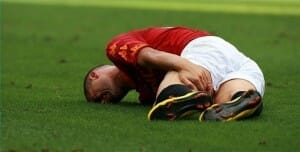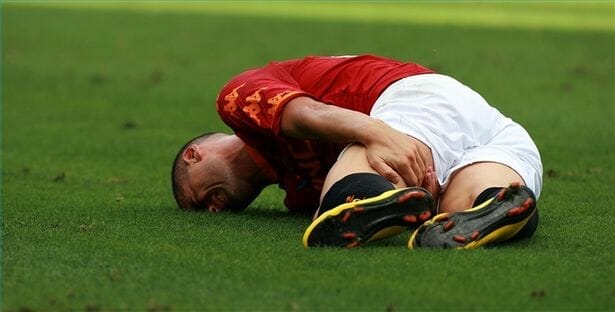
In this series I will tell you:
- What an acute hamstring strain involves, why it WILL get better and what to do it the first 72 hours
- How to treat it yourself with an accelerated rehab program, backed by research.
- How to prevent hamstring injury in the long-term, because you do not want this happening again.
What us Acute Hamstring Strain
You may know it by a different name:
- Hamstring tear
- Torn Hamstring
- Pulled hamstring
- Ohhhh I’ve done my Hammy!
Hamstring strains are very, very common – I have had two myself paying rugby.
Hamstring Injuries are common in sports that involve high-speed running, change of direction and kicking, including; basketball, track, rugby, football etc.
It is the single most common injury in football making up a huge 37% of all muscle injuries in elite footballers and on average there is five hamstring injuries per squad, per season(1). This adds up to a lot of time out from sport
Given this high injury rate and that 12-43% re-injure their hammies – It is important to rehab properly to get back faster AND prevent re-injury(2).
Mechanism of hamstring injury:
Hamstring strains generally happen at the end of swing phase of running – Just when your heel/foot is about to touch down. This is because the hamstring is:
- On stretch
- And contracting hard to slow down your foot
This is when your hamstring is working hardest – to really absorb energy to slow your leg swinging forward while eccentrically contracting (controlling the muscle lengthening out).
The hamstring is so prone to injury because it crosses two joint – the hip and the knee. This means at one end of the muscle it is contracting and the other end it is lengthening out. This along with the fact that athletes all too often concentrate on strengthening their quads (the opposite muscle) – leading to a mismatch and increased injury risk.
How bad can Hamstring injuries be?
Muscles injuries are graded simply into three categories:
- Tearing a few muscle fibers
- Mild pain and minimal loss of strength
- Pain brought on with passive stretching and resisted contraction
- You may be able to continue playing and very unlikely that you would go down
Grade 2:
- Partial tearing of the muscle
- Some strength loss
- Significant pain on resisted contraction and stretching
- Limping is very likely
- You may go down
- Bruising may appear after 2-3 days
Grade 3:
- Severe or complete rupture of the muscle
- May be a large lump in the muscle above a depression (hole) where the tear is
- You will go down and generally lie on your back, holding your thigh, feeling like you’ve been shot
- Walking is very difficult and crutches are needed for a short period
- Bruising will appear after 1-2 days
- May need surgical repair
Note: If you fit the Grade 3 criteria – Go and get it checked out by your local Physio as these do need surgery at times if there is a complete rupture
Quick anatomy of the Hamstring muscles:

The most common place for a hamstring injury is the Biceps Femoris muscle (the most lateral/outer hamstring), most often at the musculo-tendinous junction. This is where the muscle attaches/blends into the tendon, making it a weak spot – There is a muscle-tendon junction both towards the top and bottom of the muscles.
What is Recovery time for a hamstring injury:
With the great hamstring rehab regime I am going to give you the average time to return to sport is 28 days. Injuries sustained while sprinting can take a little longer (about 43 days Vs 23 days) meaning they can take generally 3-6 weeks(3).
Rehab Regimen to treat Hamstring Strain fast
Initial self – treatment:
In the first 72 hours it is very important to follow the RICE and HARM principles – This will take weeks off your recovery.
Do: RICE
-
- Rest – From running etc.
- Ice – 10 minutes at a time, no more, every hour you are awake.
- Compression – Eg Tubigrip.
- Elevation – Get your foot above your heart when possible.
Don’t: HARM
-
- Heat
- Alcohol
- Running
- Massage
HARM increases blood flow to the area, worsening inflammation and so causing more secondary damage and a longer healing time.
Keep moving (within reason of course):
Start weight-bearing through them as soon as possible to normalize movement and decrease loss of muscle activity for grade 1-2 muscle tears. If necessary you may need to be on crutches for the first 24 hours (if very painful and you really have tried to walk on it) then move to partial weight-bearing and then full weight-bearing.
Footwear:
Wearing good supportive footwear with heel and arch support(such as your runners) is great as this takes the pressure off the hamstring injury. Do not wear Flip-flops – please!
Start Rehab Protocol
After the first 72 hours of doing this, you will need to start your rehab protocol
You might also be interested in:
Can’t touch your toes? Improve hamstring flexibility fast! – If you don’t have a tear, this is great to do.
Check out this quick balance and stability test when healing well to check if your hip strength is holding you back (especially if you have had a lot of lower limb injuries lately).



